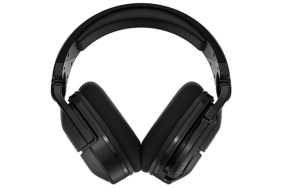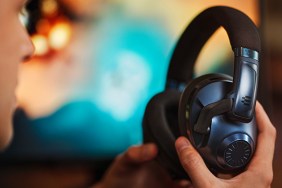Rock-quency.
Some people just don’t get it. Why would anyone play Rock Band without the instruments, let alone on a handheld? Wouldn’t that be like playing Dance Dance Revolution with the controller? To be frank, those are both fair questions… if you ignore the history of Harmonix and, well, the rhythm-based genre in its entirety.
[image1]I must admit that pressing a button on a standard controller instead of a button on a plastic instrument is “so last-gen”, and that pressing a button as an analog for actual musical play is silly. (Do you think I would pose the question on playing DDR with a controller without being one if its practicioners?). But if there is any merit in providing the following evidence – Gitaroo Man, PaRappa The Rapper, and Harmonix’s own Frequency and Amplitude – then it would be fairer to judge Rock Band: Unplugged versus those games than against Rock Band alone.
An explanation of Unplugged could go several ways, either on the basis that you, Mr. Reader, have only played Rock Band or Guitar Hero and/or have only played Frequency or Amplitude, or haven’t played any of them at all. I’ll just assume the worst-case scenario, but for those of you familiar with both franchises, it’s mostly just the career mode of Rock Band with Amplitude-style gameplay for all its songs. If that’s you, you can comfortably skip the next paragraph.
Imagine if you will, four tracks that are scrolling toward you like a conveyor belt, at the speed of the beats per minute (bpm) of the song, with the tracks representing the guitar, bass, drums, and vocals (odd that capsules can represent vocals but it works). On those tracks, notes in the shape of capsules need to be blasted away before they pass, by pressing left for red, up for yellow, triangle for green, and circle for blue. This is only on the default settings – you can change the controls to whatever D-pad and face buttons you want.
Meanwhile, you will have to shift from track to track, making sure that none of them go unattended for too long. It’s a game of spinning musical plates, really. To activate a track, effectively auto-playing it for about three phrases, you need to hit about two to four measures worth of notes without making any mistakes. Also at certain times, a solo in the song appears that has you focus on a particular instrument that has an intricate melody. Done correctly, the capsules release the musical notes that are on the given track; if not, the health for that track goes down until the crowd can’t tolerate your atrocious rhythm anymore. String together enough phrases and your multiplier grows higher, and the points you accrue will skyrocket into the five gold-star range.
[image2]What this means is that Unplugged is harder than Amplitude… and easier at the same time. Each track has four colored capsules, instead of three, and the addition of chords and a higher frequency of sixteenth notes have spiked the difficulty. The way the default settings are configured, hitting the red and yellow chord or the green and blue chord by pushing diagonally, is awkward – which the designers also seem to notice since these chords don’t come up too often. The controls are also a tad touchy, in part because the PSP buttons don’t provide much force feedback.
On the other hand, the four-button layout is spread across both hands, so hitting a tight series of notes isn’t too difficult. Another point of ease is a new half-measure break where no capsules are present right after each phrase, so that you can transition between tracks without being in too much of a panic. Though switching between tracks can be as tricky as hitting the notes themselves, a much appreciated Track Wrapping option has been provided that allows you to switch from the leftmost track to the rightmost track (and vice versa) with the flick of one shoulder button.
That said, you are allowed about four to six mistakes before losing your five-star rating, a suitable challenge for perfectionists; even more so with Band Survival mode, which disables the auto-play after activating a track. Newbies aren’t ignored, either – a Warmup mode that disregards the health of the tracks you’re not playing at the moment slightly levels the learning curve.
Surrounding all of this is the career mode, copied and pasted from Rock Band, with the exception of the replacing the song list with a new one featuring 41 songs, ranging from “Kryptonite” by 3 Doors Down, “Float On” by Modest Mouse, “Less Talk More Rock” by Freezepop, and a gamut of other familiar songs from the Rock Band franchise. The list could have benefited more from songs with synth tracks, say from Frequency or Amplitude, but that’s okay. Progression doesn’t change: Create your four-person band from a limited “handheld-sized” number of options, play songs in your hometown, earn stars, money, and fans, unlock new venues, hire staff members for extra perks, complete setlists that reward you with a better set of wheels, and continue doing so until you reach rock immortality.
[image3]It’s a bit unnerving to discover that the last song of the main game is “Livin’ on the Prayer” by Bon Jovi, when the hardest song, “Painkiller” by Judas Priest, is available in the same city and that “Livin’ on the Prayer” needs to be played about three other times before reaching the end. Between playing each song individually as well as within the required setlists, some of the easier songs repeat themselves often, enough so that they can become a nuisance. By the fourth time listening to “I Was Wrong” by Social Distortion, I begin thinking the same thing. Fortunately, the tracklist is mostly composed of classics like “Pinball Wizard” by The Who and “White Wedding Pt. 1” by Billy Idol, so the repetition doesn’t get too wearisome.
The only substantial complaint is the tumbleweed-laden silence that fills the multiplayer space. Local or online, multiplayer is absent, which is strange because it would seem obvious and easy to have two players simply play two different tracks tracks simultaneously – either as players for specific instruments or as two plate spinners, so to speak, who can switch between each track freely. There should have been at least one multiplayer mode that Harmonix could have conjured out of their millionaire-hats to maintain the obvious multiplayer bullet point in the Rock Band brand.
There’s no question that Rock Band is better with instruments, but on the handheld, given that the primary comparison is Guitar Hero: On Tour which comes with the multi-colored, pro-arthritis death vice, I’m glad there aren’t any here. You could also argue that Unplugged steals the Rock Band name for the sake of branding Amplitude in a prettier, more appealing package, and while that’s true to an extent, it’s difficult to admonish Harmonix for reviving one of its established but generally unnoticed franchises in a way that it is noticed – and that is ultimately awesome.
-
Solid <b>Amplitude</b>-based gameplay
-
<b>Rock Band</b> career mode
-
Strong tracklist
-
No multiplayer whatsoever







